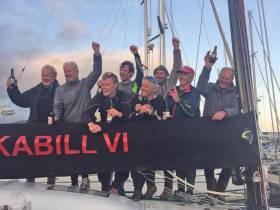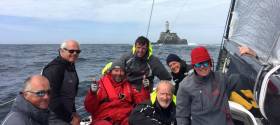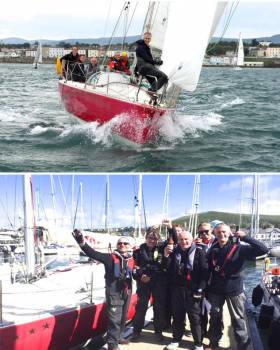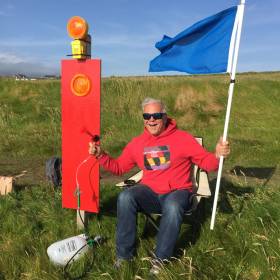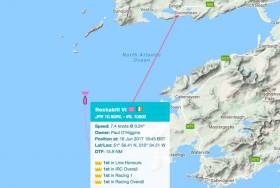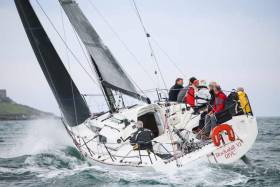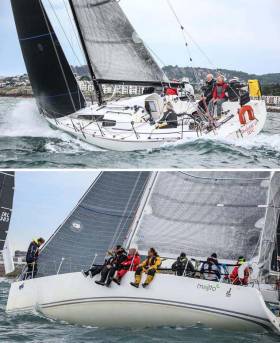Displaying items by tag: Dun Laoghaire to Dingle
Paul O’Higgins (RIYC) is November’s Afloat.ie “Sailor of the Month (Offshore)” for the sporting way he campaigns his JPK 10.80 Rockabill VI.
He knew when to make it serious to win the Volvo Dun Laoghaire to Dingle Race, but equally he won his class in Calves Week as part of a family holiday.
And he gallantly campaigns the DBSC Turkey Shoot as a front runner on the water, but carrying a stratospheric handicap.
Martin Crotty 1945-2017
Martin Crotty of the National Yacht Club, one of the great enhancers both of our sport and of life itself, has been taken from among us all too soon, and the thoughts of the Irish sailing community – and a broader community beyond it at home and abroad – are very much with his family, his many friends and his clubmates in a sad loss in which we all share.
He started sailing at an early age, and became a stalwart of the Dun Laoghaire Flying Fifteen class in partnership with Jim Gorman, father of current Flying Fifteen pace-setter David Gorman. But Martin’s intellectual curiosity, and interest in a more complex form of sailing with a broader scope, then led to a partnership with Peter Cullen in the Everitt-designed Half Tonner Eliminator, which they campaigned very actively with increasing success.
By going into the Eliminator partnership, Martin began a dynamic boat-owning linkup with Peter Cullen which was to last the entire 38 years until his death on Saturday. Peter Cullen and Martin Crotty were much more than just a boat-owning duo – they were close friends, they complemented each other, their different abilities and personality traits were mutually beneficial, and they fairly crackled with ideas for the development and improvement of sailing.
Their partnership progressed through three more boats – the David Thomas-designed Bolero 35 Nyala (“rather over-canvased, but great sport and unbeatable in her special conditions”), and then another but very different David Thomas design, the hefty yet speedy Sigma 41 Koala which they campaigned and cruised from 1991 to 1999 through nine very active seasons, with thousands of miles logged.
They then “settled down a bit” with the handsome dark blue Beneteau 50 Zig Zag, which in fifteen and more seasons has cruised extensively to many parts of Ireland, but France and Spain – particularly northwest Spain – have also been much favoured. A couple of years ago, to mark Martin’s 70th birthday, he and Peter made what was to become their last extensive cruise together, out to northwest Spain and back again, two crossings of the Bay of Biscay.
 Quietly happy aboard his boat – Martin Crotty at the helm of Zig Zag. Photo: Peter Cullen
Quietly happy aboard his boat – Martin Crotty at the helm of Zig Zag. Photo: Peter Cullen
Ashore, Martin was a surprisingly private person for one who played so many key roles across a wide range of interests, some of them highly visible. He was actually qualified as a barrister, yet never practised, for despite his never-failing politeness and tendency to be a backroom operator, he was fascinated by the world of corporate business, and achieved notable success and fulfillment in his career in Corporate Design.
As for his input into sailing, his best-known innovation was the introduction, with the full backing of Peter Cullen, of the biennial Dun Laoghaire to Dingle Race in 1993. This really was totally new. Many people had thought of a non-stop Round Ireland Race long before Wicklow Sailing Club finally bit the bullet with total dedication in 1980. But absolutely no-one had thought of anything like a 280-mile race from the stately harbour of Dun Laoghaire in all its style on Dublin Bay, all the way to one of the most westerly fishing ports in Ireland, a place so redolent of the majesty of the Atlantic seaboard that it could have been on a different Continent. Yet thanks to the Crotty-Cullen initiative, the two very different ports were brought together and have maintained this unique, wonderful and growing seafaring and sporting bond ever since.
However, even an event as strong as this suffered from some numbers depletion during the Economic Recession. But although he had been running it for more than 15 dedicated years, Martin was determined to see the D2D back to full health before finally handing it over. In the Spring of 2017, with entries for the up-coming race in June already at record levels, he finally made the full administation handover to Adam Winkelmann, whom he had recruited to shadow his staging of the race in 2013, when signs of recovery were already beginning to become evident.
But although the hugely popular Dun Laoghaire to Dingle Race is Martin Crotty’s most tangible legacy in Irish sailing, he should be remembered for much else. He was himself an excellent sailor, with that perfect combination of courage, ability and good sense which provides the perfect shipmate. He was fascinated by traditional navigation – he was a skilled hand with the classic sextant – yet he was equally adept with the most modern technology, and as Peter Cullen puts it, “There was no better man to have around when the electronics were acting up – he was better than many professionals”.
Another aspect of his wide-ranging personality was an encyclopaedic knowledge of flag etiquette. Quite how he managed to find the brain space for this arcane subject in his already well-furnished mind is a matter of wonder, yet the way of thinking which this indicates made him a formidable committee man, and he rose through the ranks to become Vice Commodore of his beloved National YC.
It was his final role with the NYC which perhaps best defined Martin Crotty. Upwards of three years ago he was appointed a Trustee of the Club. Some club Trustees are sometimes no more than names at the top of headed notepaper. But at a difficult time for yacht club life throughout Ireland as we struggled out of recession, Martin Corry was a Trustee that the Commodore and every committee in the National Yacht Club knew they could readily call on for the most sage and useful advice for each and every difficult decision.
Speaking today in fond remembrance of his friend Martin Crotty, National Yacht Club Commodore Ronan Beirne remembered his many services to sailing, but he spoke in particular of his solid reliability in his final role as a Trustee: “He was our rock. He would be completely measured, sound and considered in his deliberations, and his advice would be proven right. We will miss him for so many things. And we will miss him for his excellent company.”
WMN
The 275-mile Volvo Dun Laoghaire to Dingle Race overall win was still open to challenge until the leader on the water, Paul O’Higgins’ JPK 10.80 Rockabill VI, had cleared the Fastnet Rock. However, with every mile sailed thereafter, it looked increasingly likely that Rockabill was on track to win every title for which she was eligible. Only a total catastrophic failure of boat or equipment was going to prevent it. But there was no failure of any kind. The JPK 10.80 comes at a significant price premium because this is a clearly defined concept which just doesn’t do boat or equipment failures. W M Nixon tries to pin down why the Dingle win seemed so special.
Success has many fathers, while failure is an orphan. As Paul O’Higgins’ JPK 10.80 Rockabill VI has increasingly found her form in Irish sailing since arriving new from the builders just over a year ago, there’s no lack of people ready to tell you how and why they counselled him to go for an expensive new JPK 10.80, rather than a reasonably-priced second-hand J/109 like so many others.
But as one of Dublin’s leading barristers, Paul O’Higgins is his own man, quiet in demeanor yet thinking on his feet at the speed of lightning, while effortlessly storing any new information in a well-furnished brain. His approach to sourcing a new boat as the 2014 season drew to a close was forensic in its analysis, and the way he picked on a JPK 10.80 before they’d hit the headlines of major success is illustrative of how he functions.
Not being a cradle sailor, he can look at boats in a coldly dispassionate way. He hadn’t sailed at all until he met his future wife Finola Flanagan at College, and as the Flanagans of Skerries were the total sailing family, he soon found himself roped into sailing with his future father-in-law Jack Flanagan on a series of boats all named Rockabill after that distinctive lighthouse-topped rocky islet that is eight miles east of Skerries out in the Irish Sea, an islet big enough to provide a home for Europe’s largest colony of the rare roseate terns.
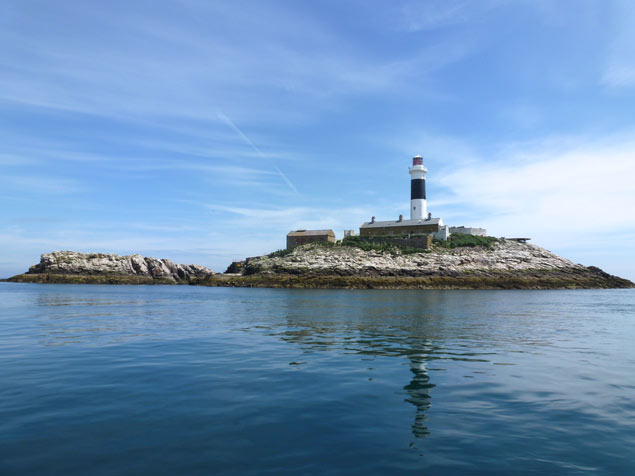 The one and only original Rockabill is still a couple of hundred miles from the Fastnet Rock. Photo: W M Nixon
The one and only original Rockabill is still a couple of hundred miles from the Fastnet Rock. Photo: W M Nixon
From being a visitor who might pull a rope when asked, the daughter’s suitor developed into a crewman, and as his taste for this weird but wonderful sport grew, he became a partner in the continuing succession of Rockabills, going into co-ownership with Jack in a souped-up First 30, Rockabill II.
By 1998, the balance was changing naturally with the passage of time, and Paul was becoming the pace-setter when they moved into a First 33.7 Rockabill III. He was competitive, yet no more naturally able at sport than most. An enthusiasm for playing rugby had been brought to an end by a knee injury, but he can still give a reasonable account of himself on a tennis court. However, it was the hugely complex wind-driven vehicle sport of campaigning a cruiser-racer under fair handicap rules which increasingly appealed to him. Having made the happy discovery that he seemed to be immune to seasickness, he stepped up his level of involvement.
His father-in-law had long since become eligible for the free travel pass, so the stage was reached where Paul bought him out while still with the First 33.7, and then with the turn of the millennium he was thinking of another boat slightly further up the Beneteau range, the highly-regarded First 36.7, and with her he achieved his first significant win in an IRC event.
Professional and family life were at their most demanding, yet somehow he found the time to campaign the First 36.7 Rockabill IV in several significant series and regattas, building up both experience and skills, while at the same time enlarging his circle of like-minded friends to create the kind of crew panel – more than twice the number of actual crew on the day - which is necessary to campaign a serious boat at this level.
With every year, however, the level became ever more demanding, and in admitting to himself that the First 36.7 was no longer cutting the mustard at the heights to which he aspired, he reckoned by 2008 that he needed to be in a Corby, and a new Corby 33 was what he could most comfortably afford.
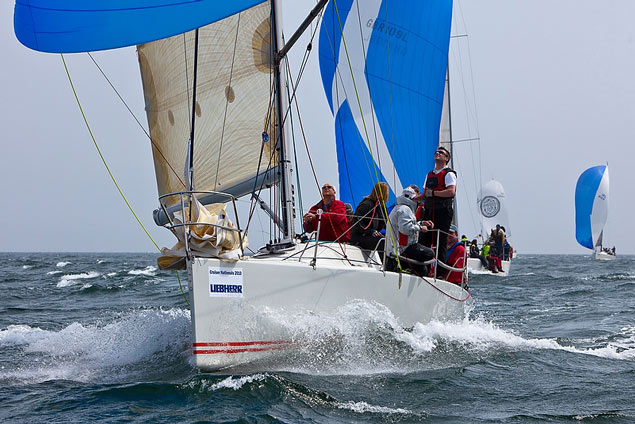 With the Corby 33 Rockabill V, Paul O’Higgins had many successful years. She is seen here racing at the ICRA Nationals 2013 at Tralee Bay. Photo: Robert Bateman
With the Corby 33 Rockabill V, Paul O’Higgins had many successful years. She is seen here racing at the ICRA Nationals 2013 at Tralee Bay. Photo: Robert Bateman
Rockabill V, the Corby 33, became a familiar sight on the circuit, always noted for putting in an interesting and often podium-gaining position, yet almost invariably guaranteed to appear at Calves Week, that amalgam of West Cork Regattas out of Schull early in August, a fun event with an underlying level of quite serious racing which fitted well with the Higgins’ family’s regular summer holidays in West Cork in August.
For a busy man ashore, his commitment to getting afloat as much as possible was remarkable, and his willingness to take part each year in an interesting series of regattas and events saw his crew panel increasing. If you were as keen as Paul O’Higgins, then as a committed panel-member you were going to get sailing. And with first places recorded in various series which ranged from Scotland to Kerry, plus regular participation in Dublin Bay where he sails from the Royal Irish YC, Rockabill V made frequent and regular appearances in the frame.
But by 2014 he began to feel that he’d gone about as far as he could with the Corby 33. She’s a very interesting boat, unforgiving in some ways yet rewarding in others. But nobody would call her luxurious, let alone comfortable. That said, Rockabill V was still winning races. But when a new boat called the JPK 10.80 appeared from a specialist yard in France in the Spring of 2014, his interest was piqued by the fact that she had race potential, yet with her considerable beam, twin rudders, and roomy and comfortable accommodation, was about as different as possible in concept from the Corby.
If he was going to make a change, why not make a complete one? The J/109 seemed an attractive idea, but when the class finally started to take off in Dublin Bay, she was no longer being built. This “new” Dublin Bay One-Design was a class made up entirely of pre-owned boats. Yet Paul O’Higgins had become accustomed to buying from new. Second-hand just wasn’t his thing.
He looked again at the JPK 10.80, and when one of the very first turned up from France to race Cork Week 2014, he was very taken with her despite the fact that in straight sailing, the crew clearly weren’t getting the best from her, while their confusion with Cork Harbour courses compounded their problems.
Paul O’Higgins bided his time until July 2015 when, despite the pressure from the J/109 lobby, he placed an order for a JPK 10.80. It was a decision soon supported by events, with a JPK 10.80 winning the Rolex Fastnet overall in August 2015, and then in December a JPK 10.80 cruising the Pacific was briefly taken out of her cruising reverie, kitted out with racing sails by Gery Trentesaux’s Fastnet-winning crew, and promptly went out and won her class in the Sydney-Hobart Race.
Yet perhaps the best thing of all about having placed his order back in July was that it entitled him to visit the new factory near Lorient where the boat was being built. He went there a number of times, finding it an inspiring place of exceptional cleanliness and precision, while the dedication of designer Jacques Valer and company founder Jean Pierre Kelbert set the tone.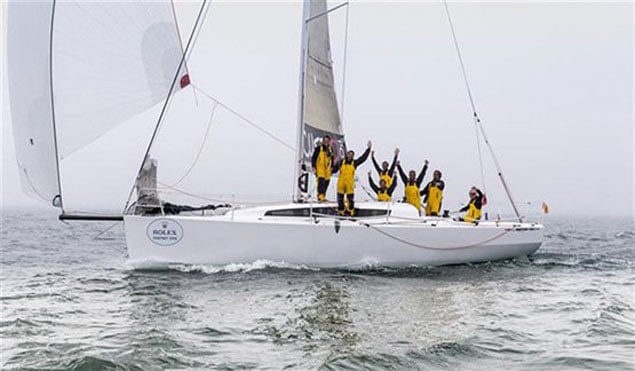 The JPK 10.80 Courier du Leon winning the Fastnet race a month after the order had been placed for Rockabill VI
The JPK 10.80 Courier du Leon winning the Fastnet race a month after the order had been placed for Rockabill VI
Thus although the situation is that an order placed today for a new JPK 10.80 would mean delivery no earlier than the very end of 2018, they are not enthusiastic about taking on extra staff to speed up production. They feel that not everyone would immediately share the JPK ethos, and the current workforce size and output is probably optimal.
 The JPK 10.80’s beamy hull shape with twin rudders was a whole world away from the narrow deep Corby concept.
The JPK 10.80’s beamy hull shape with twin rudders was a whole world away from the narrow deep Corby concept.
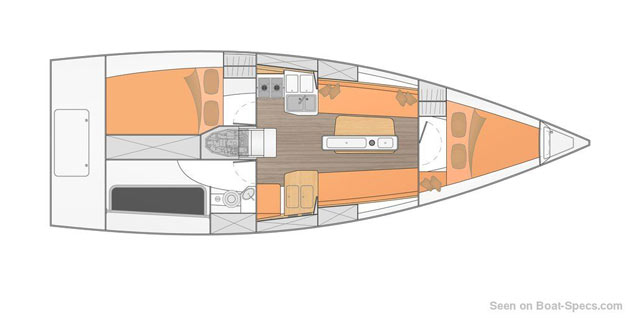 The accommodation is surprisingly roomy and comfortable for a boat which has now added the Dun Laoghaire-Dingle Race win to overall victory in the Fastnet and a class win in the Sydney-Hobart.
The accommodation is surprisingly roomy and comfortable for a boat which has now added the Dun Laoghaire-Dingle Race win to overall victory in the Fastnet and a class win in the Sydney-Hobart.
It may be frustrating for someone who is keen but hasn’t yet made the commitment, but for those already on the ladder or with a JPK 10.80 sailing and winning, it serves to keep the boat’s value very high. You don’t buy a JPK 10.80. You invest in one.
But when Rockabill VI first arrived in Ireland early in the season of 2016, the light airs of her debut event, the ICRA Nationals at Howth, didn’t suit her initial configuration of small sails planned to fit into the preferred IRC Rating band for the best racing in Dublin Bay.
However, for the Round Ireland Race 2016 later in June, she was at her sparkling best for the fast run up the west coast, and seemed to have a class win in the bag when she hit a localised total calm at Inishtrahull. Rockabill VI and a couple of other boats nearby simply sat there for nearly four hours while the closest competition, the J/109 Euro Car Parks (Dave Cullen), came up from very many miles astern with her own breeze to knock Rockabill off the leader perch. With light airs when beating down the Irish Sea, the under-canvassed JPK 10.80 Rockabill VI failed to re-take the class lead.
So although there were many wins in 2016, particularly when there was a good breeze or lots of high-powered offwind stuff, and preferably both, Rockabill VI was on the money, but through the winter Paul O’Higgins implemented a plan to step up the sail area and take the ratings hit.
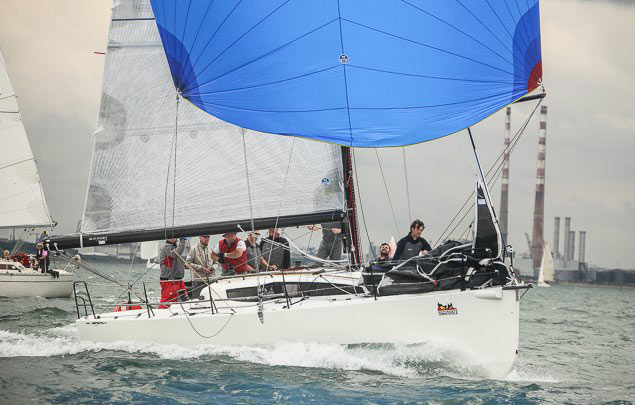 Rockabill VI in the totally familiar surroundings of Dublin Bay Photo: Afloat.ie
Rockabill VI in the totally familiar surroundings of Dublin Bay Photo: Afloat.ie
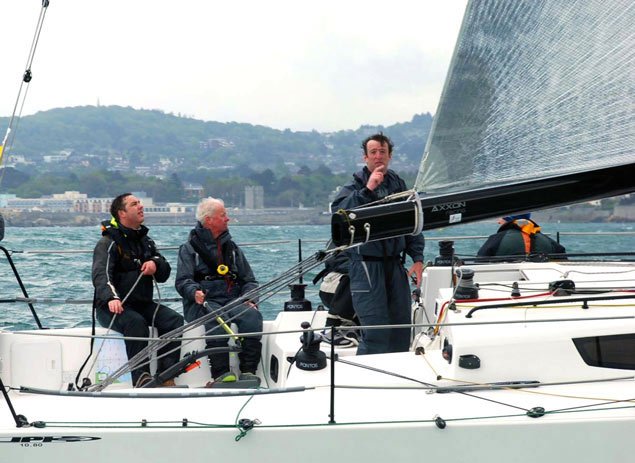 Paul O’Higgins on the tiller as Rockabill VI wins the Holyhead-Dun Laoghaire Race 2017
Paul O’Higgins on the tiller as Rockabill VI wins the Holyhead-Dun Laoghaire Race 2017
Most observers are confident that it will pay ultimately pay off, yet oddly enough there has only been one major race this year in which its success was clearly demonstrated. The Holyhead-Dun Laoghaire – which she won – was a freed-sheet breezy sprint, while the Dun Laoghaire-Arklow was a calm-bedevilled flukerama. So the only true test was the hybrid ISORA Howth-Lambay-Poolbeg race on June 3rd, in which the ISORA fleet sailed Howth YC’s Lambay Race in a gesture to Howth Regatta, but then continued on through the finish line to finish at the Poolbeg Y&BC line as a gesture to the Dublin Port Riverfest.
Hybrid or not, it demonstrated that Rockabill VI’s new configuration was a race winner, but after that there was little opportunity for any further testing before the National YC’s Volvo Dun Laoghaire-Dingle race got under way at 1900hrs on Wednesday June 14th.
We’ve carried at least a dozen continuing reports on Afloat.ie, so there’s no need here to tell you of the ins and outs of a classic race, but what was it like on Rockabill VI, which so convincingly won?
By this stage in a sailing career which has been going on for nearly 35 years, Paul O’Higgins has a trusted crew panel of between 15 and 20 centred on Dublin or Cork upon whom he can draw, and putting together a campaign team of eight for the Dingle Race neatly drew the balance between who was available, who was really keen, and those whose abilities would best complement the core squad which was emerging.
Topping the list was Paul himself and his son Conor, while regular helmsman Mark Pettit was also in from the start. The other main helm became Peter Wilson, whose skills on the tiller or wheel are legendary, and he also brought the kudos of having been a key member of the crew with which Richard Burrows won the very first Dingle Race in 1993 with the Sigma 36 Black Pepper.
Central to the crew was Ian O’Meara of Viking Marine in Dun Laoghaire, who in addition to knowledge of equipment and considerable sailing skills, is married to Jacquie Marsh who heads that very special catering setup, The Butler’s Pantry. Rockabill VI raced with a balanced selection of pre-prepared meals from The Butler’s Pantry, and when feeding time came around, they feasted like kings in the remarkable comfort which this very exceptional boat is able to provide.
Through his contacts on the Dun Laoghaire waterfront, Ian O’Meara had introduced a recent recruit to the crew panel, Will Byrne who was Captain of UCD Sailing in recent years when they’ve been winning every which way. He has also logged offshore racing experience with the RORC programme in the English Channel each summer, and he brought youth and extra skills to the crew for Dingle.
 Will Byrne (right) with his new shipmates at the Fastnet. He was a highly successful Captain of UCD sailing and a veteran of RORC events, but had not sailed the Dingle race before. Photo: Paul O’Higgins
Will Byrne (right) with his new shipmates at the Fastnet. He was a highly successful Captain of UCD sailing and a veteran of RORC events, but had not sailed the Dingle race before. Photo: Paul O’Higgins
Two frequent crew regulars on Rockabill – Rees Kavanagh who knows his way round many boats, and Ian Heffernan who is a professional maritime instructor, made up the total of eight. They were divided into a rolling system of pairing which means that at any one time, there’s always a minimum of four on deck, but proper off-watch spells are guaranteed, as Rockabill VI is laid out in such a way that three people can be fully off-watch and sleeping, yet they’re right up against the weather side of the boat.
This may sound self-indulgent for people who expect to spend a night on the weather rail, but it was part of the formula which contributed to Rockabill’s success. As Paul O’Higgins puts it:
“You really do get a proper little spell of sleep. To begin with, the boat is so well built there is no water finding its way below. Troublesome drips from above are unknown. You won’t find the sleeping bag is slowly dampening from some hidden little puddle. And within the limits of slugging to windward off Ireland’s south coast, she’s as sea-kindly as can be, particularly when you have helmsmen of world quality who know that a banging boat is a slow boat.
But always, there’s the reassurance of knowing how well she is built. She’s definitely not going to fall asunder under you and about you. There’s no better recipe for a refreshing sleep when it’s your turn to be off watch”.
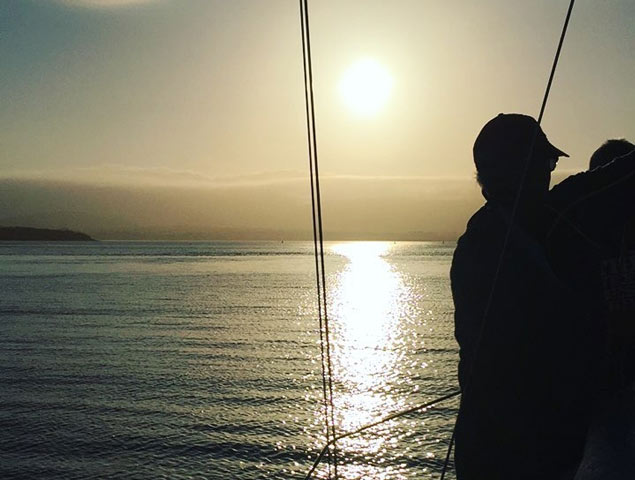 Perfect end to a great race. Summer evening as seen from Rockabill VI heading into Dingle. Photo: Will Byrne
Perfect end to a great race. Summer evening as seen from Rockabill VI heading into Dingle. Photo: Will Byrne
Thus Rockabill VI’s inbuilt advantage over the opposition simply increased as the race went on. Others were giving it best and retired as the going got tough and stayed tough, but on Rockabill, they were on top of it - and enjoying it too.
That said, with the increased rating, they knew that they were vulnerable to any unexpected calm and the constant challenge of the three chasing J/109s, to all of whom they gave quite a bit of time. It was an itch to be scratched .The owner-skipper at his navigation and tactics took to referring to the nearest one, Peter Dunlop & Vicky Cox’s Mojito, as Mosquito.....
Yet most of the time, Rockabill was stretching her lead on Mosquito. When she got to the Fastnet towards 1000 hrs on the Friday morning, they’d lengthened it to eleven miles. A celebratory crew photo with the rock in the background was assembled by Will Byrne, but helmsman Mark Pettit, a very serious person, thought such frivolity was premature.
Evidently the Fastnet Rock agreed with him. It served up a slack patch and a very lumpy sea, and for an agonising period their speed dropped to 3.8 knots. But they got clear of its clutches, and the notorious flat at Mizen Head only slowed them back to 4.4 knots for a while.
And then they were gone, piling on the knots in a warm southwesterly which became stronger the nearer they got to the finish. They came past Skellig Michael at 8.8 knots. The last nine miles into Dingle were seen off in less than fifty minutes. They’d won everything by a country mile and then some. After the finish, they were lined up for photos. History was made. Mark Pettit smiled.
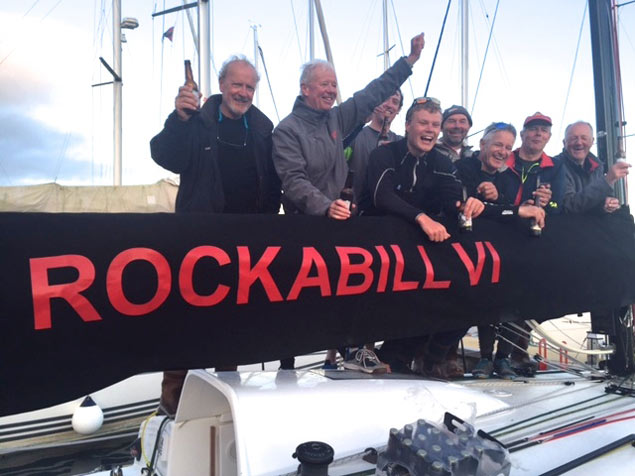 History is made. Mark Pettit (right) is recorded as smiling (well, sort of) at the crew-lineup in Dingle. Others in the photo are (left to right) Peter Wilson, Paul O’Higgins, Will Byrne, Conor O’Higgins, Ian Heffernan, Rees Kavanagh and Ian O’Meara. Photo: Con Murphy
History is made. Mark Pettit (right) is recorded as smiling (well, sort of) at the crew-lineup in Dingle. Others in the photo are (left to right) Peter Wilson, Paul O’Higgins, Will Byrne, Conor O’Higgins, Ian Heffernan, Rees Kavanagh and Ian O’Meara. Photo: Con Murphy
The plans for the rest of the season are very conservative, for this is first and last a Corinthian boat. As a busy lawyer, Paul O’Higgins’ free time is constrained, and he reckons something like a Fastnet campaign is simply too demanding of time, money and other resources when the energy would give a better return deployed in other ways, and his family have always had other ways of being near the Fastnet Rock during August.
So Rockabill VI will return to Dun Laoghaire for DBSC racing, the Volvo Dun Laoghaire Regatta preceded by ISORA’s Lyver trophy Race, some other ISORA events, and then full-on participation in Calves Week out of Schull as part of a family holiday in West Cork, when the boat’s excellent cruising potential will also be utilised.
It’s Irish sailing at its best. This is how it should be done. Topped off with the Dingle Race win before midsummer was even upon us, it’s a very attractive balance.
Read our 2017 Dun Laoghaire–Dingle Race Reports in one handy link here
In Dingle This Afternoon, Everyone’s a D2D Winner
The mood is good in Dingle this afternoon. And while some have hard-won successes to celebrate, others have the simple fact of getting there at all to further brighten their already bright day writes WM Nixon. For the National Yacht Club’s Volvo Dun Laoghaire to Dingle Race 2017 was a toughie until you got yourself past Mizen Head. But after that, the coasts of West Cork and Kerry brought the reward of champagne sailing with a warm fair wind.
There are still some boats racing as we write this at 1300hrs, and out in Dingle Bay the surprise is that Marcus Ryan in the Mini 650 Port of Galway Black has got ahead of Yannick Lemonnier and Dan Mill in the other still-racing Mini, Port of Galway Green.
Doubtless there’ll be some further explanation for this reversal of fortune when the two little boats get to port in due course, for it’s only as de-briefings –official and otherwise – take shape that we get the full story.
One thing is absolutely clear. Paul O’Higgins’ JPK1080 Rockabill VI has won overall by every known method of calculation, with Peter Dunlop & Vicky Cox’s J/109 Mojito taking second for the second time in a row.
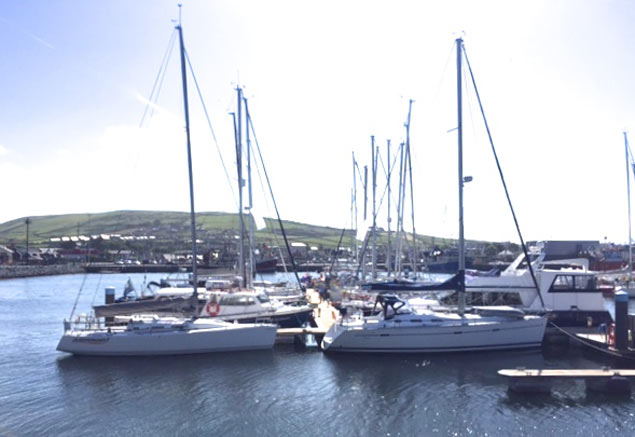 Some of the fleet from Dun Laoghaire in Dingle Marina this morning. Photo: Adam Winkelmann
Some of the fleet from Dun Laoghaire in Dingle Marina this morning. Photo: Adam Winkelmann
In another area, the continuing drama of who would win the Two-handed Division came down in the end to the unlikely matching of Stephen O’Flaherty & David Cagney on the modern classic, the Spirit 54 Soufriere, against the 20ft shorter Dehler 34 Big Deal from Foynes, sailed by father and son duo Derek and Conor Dillon.
While Soufriere held the lead at times, Big Deal was always ready to pounce, and the acceleration towards the end helped her in this. In port at the finish, however, it has emerged that for several hours of the race Soufriere was only jogging along under jib only, as the two boyos had discovered that the lazarettes – the pair of vast lockers under the after-deck in that long and elegant counter – were full of water.
Soufriere’s crew pumped and bailed like blazes while their big boat ambled along, and then when the situation was under control again, they simply resumed racing without a word to anyone about a “slight problem”.
Although the results in Racing 1 were for a long time fixed at Rockabill VI first, Mojito second, Andrew Algeo’s J/109 Juggerknot third, and the Shanahan family’s sister-ship Ruth fourth, in Racing 2 things were more fluid.
Racing 2’s early longtime leader, the Granada 38 Cavatina (Ian Hickey) lost first place to the Irish Offshore Sailing’s school yacht, the Jennneau 37 Desert Star (Ronan O Siochru), down toward the Fastnet. With some nicely-called tacks, Desert Star nipped into the lead. But in the long haul up past the majestic headlands to the next major turn at Skellig Michael, Cavatina took it back and kept it after Desert Star got hung up for a while in the flat patch at Mizen Head, while Liam Coyne’s First 36.7 Lula Belle was steadily in third for much of the race.
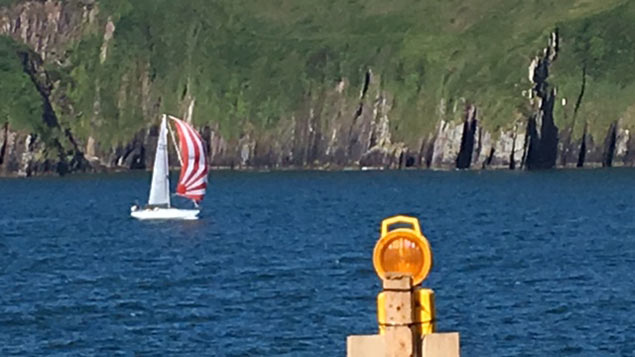 The Jeanneau Sunfast 37 Windshift (Brendan Couglan) finishing the Dingle Race this morning. She placed fourth overall in Racing 2. Photo: Cathy MacAleavey
The Jeanneau Sunfast 37 Windshift (Brendan Couglan) finishing the Dingle Race this morning. She placed fourth overall in Racing 2. Photo: Cathy MacAleavey
The Cruising Division saw Paul Sutton’s Dufour 40 Pipedreamer in the lead virtually throughout, with the Fulmar 32 Fulmar Fever (Robert Marchent) second. It seems that the early listing of the Tyrrell family’s J/112E Aquelina as a cruiser – and the winning one at that - was as a result of computer glitch.
So Aquelina is in Racing 1, and she’ll stay at fifth in Racing 1 even with the redress they’ll get for standing by the J/109 Sgrech when she started leaking back at Carnsore Point early on Thursday morning. That’s an incident, a time and a place which, in sunny Dingle this Saturday afternoon, now seems a very very long time ago.
Let’s hope this afternoon the Race Finishing Team headed by Con Murphy can grab a bit of sleep, for it has been one extremely long night for them. Some turbo-powered energy is going to be needed by everyone for tonight’s epic prize-giving party at Benner’s Hotel. Justice must be done to a gloriously crazy way to round out a great race.
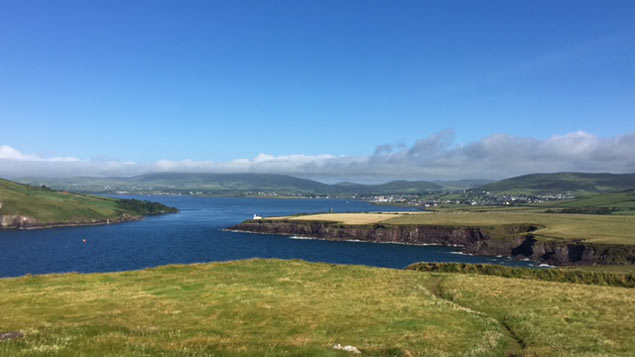 Sunny Dingle as seen from the finishing team’s hilltop station. Photo: Cathy MacAleavey
Sunny Dingle as seen from the finishing team’s hilltop station. Photo: Cathy MacAleavey
National Yacht Club Finish Line Team Standing By in Dingle
It's been a helluva race with a record turnout – and a record dropout – since Wednesday evening's Dun Laoghaire to Dingle start. Now, after an epic 48 hours ago, the National Yacht Club organisers have relocated to the County Kerry finish line, ready to offficiate at what looks almost certain to be a line honours victory – at least – for Paul O'Higgins Rockabill VI.
Up to 20 boats from a starting fleet of 43 will follow, not least a tightly packed trio of J109s, currently just 15 miles behind Rockabill
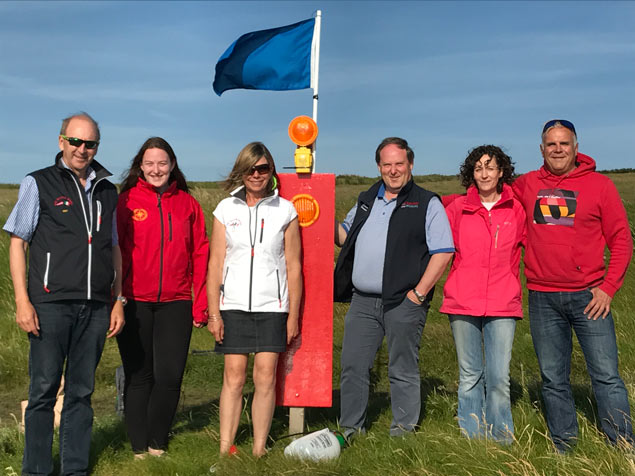 The NYC finish team in Dingle tonight: Con Murphy, Grainne Ryan, Cathy MacAleavey, Peter Ryan, Suzie Barry and Adam Winkelmanm
The NYC finish team in Dingle tonight: Con Murphy, Grainne Ryan, Cathy MacAleavey, Peter Ryan, Suzie Barry and Adam Winkelmanm
Rockabill Speeds into Dingle Bay in the Lead
Paul O’Higgins’ JPK 10.80 Rockabill VI has been piling up the pressure from the front on the chasing opposition in the Volvo Dun Laoghaire to Dingle Race 2017 writes W M Nixon. She swept up to Skellig Michael at 8.8 knots in the sou’wester around 1730 hrs well in the lead, and then in shaping her course into Dingle Bay with twenty miles to the finish, she was still going good at only slightly reduced speed of 7.1 knots.
Tracker here
On down the line, fortunes have varied enormously, and anyone watching the Tracker has felt helpless as one boat after another wandered into the local flat patch at Mizen Head, with their speed falling right away.
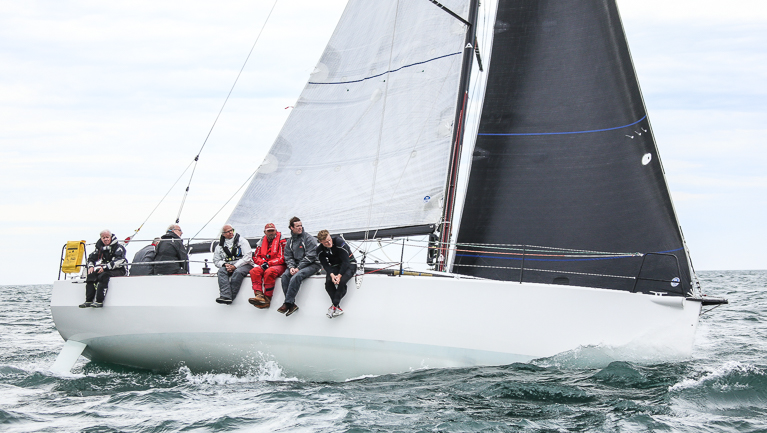 The Royal Irish YC Rockabill VI crew on the D2D were Paul O'Higgins, Conor O'Higgins, Mark Pettit, Ian O'Meara, Peter Wilson, William Byrne, Rees Kavanagh and Ian Heffernan Photo: Afloat.ie
The Royal Irish YC Rockabill VI crew on the D2D were Paul O'Higgins, Conor O'Higgins, Mark Pettit, Ian O'Meara, Peter Wilson, William Byrne, Rees Kavanagh and Ian Heffernan Photo: Afloat.ie
The gallant charge of the Spirit 54 Soufriere (Stephen O’Flaherty & David Cagney) came to a virtual halt here. For long enough – or so it seemed - the Two-handed Division leader sat almost paralysed at barely a knot while smaller lighter boats such as Andrew Algeo’s J/109 Juggerknot, which had been right beside her, were able to slip away in the slightest sharpening of the light air and get back up to speed off the mouth of Dunmanus Bay.
But now Soufriere has got herself going again at 1800hrs, and is getting up to speed at 6.8 knots, yet the J/109s around her – with Juggerknot a bit over a mile ahead and Ruth (Shanahan family) much the same distance astern astern – are matching the pace.
Peter Dunlop & Vicky Cox’s leading J/109 Mojito is in turn just under three miles ahead of Juggerknot, but that puts her all of 15 miles behind Rockabill, which has been sailing a remarkable race. But then you’d expect that with helmsmen of the calibre of Mark Pettit and Peter Wilson aboard, the latter having an unrivalled record in this race as he played a key role when Richard Burrows’ Sigma 36 Black Pepper was overall winner of the first dash to Dingle in 1993.
Within classes, the Tyrrell family’s J/112E Aquelina continues in a solid lead in the Cruiser Division, and is midway between the Fastnet Rock and Mizen Head making 6.4 knots on course, while in Racing Division 2, the leader on the water, Irish Offshore Sailing’s Jeanneau 37 Desert Star skippered by the sailing school’s principal Ronan O’Siochru, is currently nearing the Fastnet. However, Ian Hickey and his Cork crew on the Granada 38 Cavatina are close enough astern to maintain their corrected time lead, while Desert Star is second.
We maligned that tough old salt Liam Coyne in the First 36.7 Lula Belle by suggesting in an earlier report today that the Round Britain and Ireland Race class winner had retired into Kinsale this morning. Lula Belle did indeed go into Kinsale Marina at about three minutes to eight this morning, but at 8 o’clock she was heading straight back out again, having presumably made the necessary drop-off of a crewman. Lula Belle is currently pacing along at better than 5 knots between Desert Star and Cavatina, currently lying third in Racing 2 where a right old ding-dong is clearly developing for the top three places.
Further down the line, the two tiny Mini Transat 650s Port of Galway Green and Port of Galway Black are by no means last on the water, and they’re just about in sight of each other and having a real race, with Green (Yannick Lemonnier and DanMill) leading from Black (Marcus Ryan).
At time of writing (1830 hrs Friday) it’s looking hopeful for a daylight finish for Rockabill VI, as she has been logging 7.3 knots tacking downwind, and has just 15 miles to go to the finish. That said, strange things can happen to the winds of Dingle Bay as evening draws on, and even as we finish writing thisdispatch, the leader’s speed has dropped to 6.9 knots...
Paul O’Higgins’ JPK 10.50 Rockabill VI has opened out a ten mile lead on the first of the chasing J/109s Mojito (Peter Dunlop and Vicky Cox) in the Volvo Dun Laoghaire to Dingle Race 2017 writes W M Nixon. In approaching Dursey Head, the Rockabill crew are sensibly taking the option of giving the headland a wide berth, as going too close to such a steep coastline can result in both wind shadow, and an even more confused sea state at the point itself.
Ten miles astern at Mizen head, Mojito is nearer to the land and her speed has fallen to 5.1 knots while Rockabill continues reaching at a brisk 7 knots in an easing southwesterly breeze which may see her speed reduced shortly, as Valentia is reporting a 9 mph southerly.
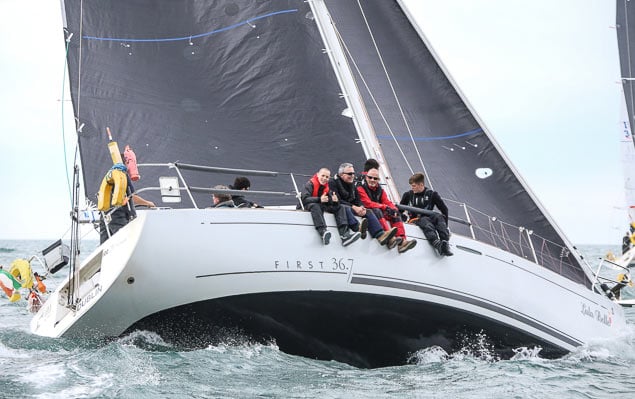 Liam Coyne's Lulabelle sailed into Kinsale to make repairs and is continuing in the race. The former RORC Round Britain and Ireland race winner brought his 13–year–old son along for his first offshore experience – what a debut!
Liam Coyne's Lulabelle sailed into Kinsale to make repairs and is continuing in the race. The former RORC Round Britain and Ireland race winner brought his 13–year–old son along for his first offshore experience – what a debut!
However, Valentia wind reports have to be taken with a dose of salt, as the actual met station is not on Valentia Island, but in the western suburbs of Cahirsiveen. It’s an impressive looking setup, but there’s no way it is recording the actual wind conditions on Valentia Island’s Atlantic coasts.
As for the rest of the fleet still in this demanding race, Stephen O’Flaherty and David Cagney in the Spirit 54 Soufriere pulled off a good move in laying out to sea last night, as they found the new sou’wester which has brought them in as neat as you please past the Fastnet in company with the other J/109s Juggerknot (Andrew Algeo) and Ruth (Ben Shanahan), which had struggled a bit to find their way out from hugging the coast.
Thus Soufriere now leads the Two-Handed Division from Derek and Conor Dillon with the Dehler 34 Big Deal, but with the wind continuing to ease it’s going to be quite a challenge keeping the big long Soufriere travelling well in the confused leftover sea. And even while we’ve been writing this at 1515 hrs, the challenges being faced are very evident with Mojito briefly in a flat spot at the Mizen with her speed down to a knot, but Soufriere and Rockabill continue at 6.5 knots.
D2D Afloat.ie Prediction: Rockabill VI Favourite But Chasing J/109 Mojito Will be Faster If Winds Lighten
As the 2017 Dun Laoghaire to Dingle Race enters its closing stages, Afloat.ie sticks its neck out and predicts how the race will pan out later today. Tide may yet play a big part in this race that looks set to reach a climax at tea time.
The Yellowbrick D2D Race tracker is saying Rockabill VI (Paul O'Higgins) is leading on corrected time and is estimated to beat Mojito (Peter Dunlop and Vicky Cox) as of 9.30am by just one minute. All of this assumption, however, is based on the boats taking the same time to complete the remainder of the race as they did to complete is so far. Rockabill VI, for instance, has a Velocity Made Good (VMG) so far of just five knots, quite similar to Mojito. It will be between these two as with the wind expected to hold for the next 12 hours, it is unlikely that a small boat will do well.
With approximately seven miles between the two boats and the tide changing in their favour shortly, Rockabill should round the Fastnet Rock by 11 am and Mojito around 12.30 pm. Should this happen, Rockabill will owe Mojito about 95 minutes on corrected time, so there will be very little between them.
Then both will crack sheets and Rockabill should have an advantage here if the breeze stays up.
However, with the tide under them the lower rated boats will fare a bit better. It could be by 3pm or so, after six hours of tide, then Mojito may have an edge. After Rockabill rounds the Fastnet and increases speed the Yellowbrick tracker will be showing her well in the lead but this is misleading as once she extends further miles in the lead, Yellowbrick will calculate her vmg to date (approx 5 knots) and use this to calculate her time advantage based on her only doing 5 knots. She will, however, be doing 10 knots, as will Mojito so a 15–mile advantage at the rock will only take Mojito 1.5 hours, but Yellowbrick will calculate it as three hours at five knots VMG.
Whoever has a code Zero between the two may also get an advantage as it will likely become that condition as the boats continue to bear away around the Bull Rock. Afloat.ie thinks tide will play a big part in this race. With Rockabill having about 70 miles to go Afloat.ie would expect her to finish about 6 pm, against the tide.
Mojito will also be against the tide at the finish so the 20 approx miles that Rockabill will be ahead by then, may take nearly three hours to cover for Mojito, which will be too long. As we write this also Mojito looks to be in lighter conditions inshore near Baltimore, whereas Rockabill is off Cape clear in stronger winds and is extending her gain.
Tracker is here
Rockabill VI Opens The Gap in Dingle Race
This morning Paul O’Higgin’s JPK 10.80 Rockabill VI has finally begun to see a more confortable gap between her overall lead position in the Volvo Dun Laoghaire to Dingle Race 2017 and the chasing trio of J/109s Mojito (Peter Dunlop & Vicky Cox), Juggerknot (Andrew Algeo), and Ruth (Shanahan family) writes W M Nixon.
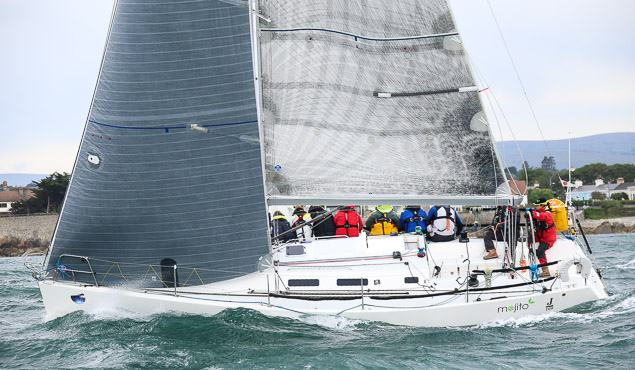 Welsh J109 Mojito (Peter Dunlop & Vicky Cox) is miles-plus behind race leader Rockabill Photo: Afloat.ie
Welsh J109 Mojito (Peter Dunlop & Vicky Cox) is miles-plus behind race leader Rockabill Photo: Afloat.ie
Off west Cork and approaching Baltimore, the fleet leader is sailing in 15mph of southwest breeze with 7 miles-plus between her and Mojito. Rockabill VI is leader on the water, in IRC overall, and in Racing 1. The strong headwinds eased during the night, but having been slightly north of west to favour those who stayed along the coast, it has now backed southwest, though in generally gentler conditions with nothing too unpleasant expected in the weather department today as the underlying barometric tendency is to rise.
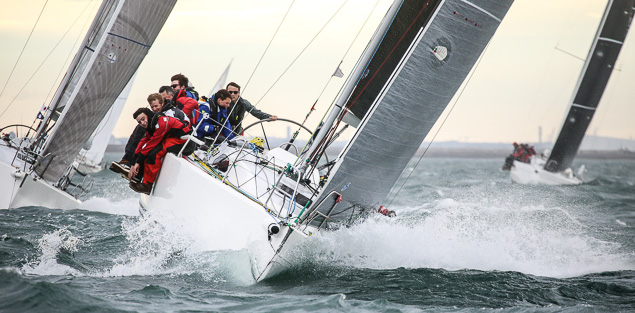 The Shanahan Family J109 Ruth, the defending D2D champion, is battling towards Dingle Photo: Afloat.ie
The Shanahan Family J109 Ruth, the defending D2D champion, is battling towards Dingle Photo: Afloat.ie
This backing to the southwest had been predicted, and Stephen O’Flaherty and David Cagney decided to take a punt on it by laying well offshore through the night on starboard tack in the Spirit 54 Soufriere, which is racing in the two-handed division. They’re now back on port tack currently laying a course which will comfortably take them to seaward past the Fastnet and the great headlands and massive sea rocks beyond along the West Cork and Kerry coasts.
 Andrew Algeo's J109 Juggerknot Photo: Afloat.ie
Andrew Algeo's J109 Juggerknot Photo: Afloat.ie
At the moment, however, it is not paying immediate dividends as they’ve slipped to fourth in Two-Handed, where the lead continues to be held by Derek and Conor Dillon in the Dehler 34 Big Deal from Foynes, while Christine Howard in the Jenneau 45 A J Wanderlust is second. But they are both well to the east and close together, currently 11 miles east-by-south of the Old Head of Kinsale. So as today rolls along, it will be intriguing to see if the Soufriere move pays off.
Lead positions overnight have remained unchanged, with the Tyrrells in the J/112E Aquelina currently off Clonakilty to maintain a position which has them in front of many out-and-out racers in addition to continuing to hold the lead in the Cruising Class, while Ian Hickey’s Granada 38 Cavatina continues to lead Racing 2. At the time of writing (0800 Friday) she’s close off Kinsale which has proven too much of a temptation for a couple battered crews and boats, but Cavatina has resolutely tacked seaward towards the Old head of Kinsale.
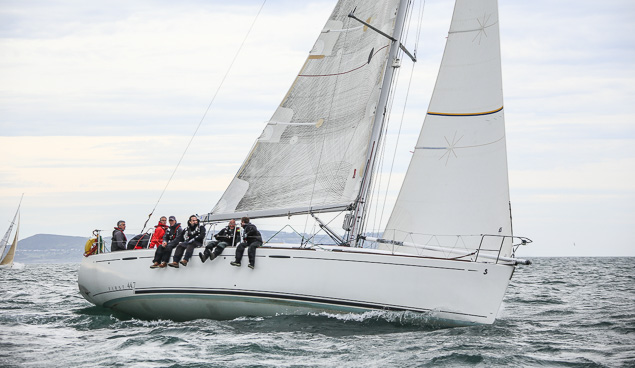 The Martin Brothers on Royal Irish Yacht Lively Lady have retired into Kinsale after a spirited run that saw them as high as fifth overall at one point on IRC Photo: Afloat.ie
The Martin Brothers on Royal Irish Yacht Lively Lady have retired into Kinsale after a spirited run that saw them as high as fifth overall at one point on IRC Photo: Afloat.ie
However, Derek Martin’s First 44.4 Lively Lady has retired into Kinsale, and it rather looks as though Liam Coyne’s Beneteau 36.7 Lula Belle – formerly a class winner in the stormiest Round Britain & Ireland Race - is doing the same.
But ahead and astern, others continue to race on, and though the Mini 650 Port of Galway Green (Yannick Lemonnier & Dan Mill) has a lead of six miles on fellow-mini Port of Galway Black (Marcus Ryan) in the Ballycotton area, both continue to compete with full-on enthusiasm.
The Gallant 25 Race On Into The Night for Dingle
“Anybody who finishes this race deserves a prize......” So said one battered yet usually successful old salt after retreating into Dunmore East writes W M Nixon. And for a while early this afternoon, retirals were coming so thick and fast that it looked like there’d be enough official prizes for everyone - maybe even with some to spare - in Dingle at Saturday night’s prize-giving.
But in fact there are still 25 boats out there racing into the night in the Volvo Dun Laoghaire to Dingle Race 2017, and they’re a bizarre mixture. For instance, the battle for the two-handed Division is now between Derek & Conor Dillon, Father and Son from Foynes with the Dehler 34 Big Deal, and Stephen O’Flaherty and David Cagney, the Odd Couple from Howth with the stately Spirit 54 Soufriere.
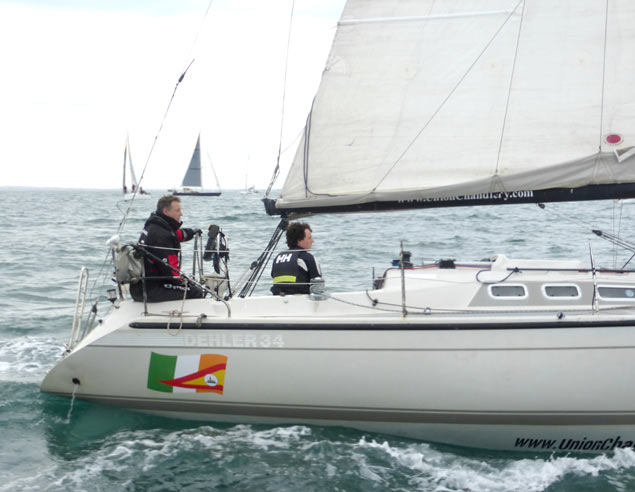
Former leaders Indian (J/109) and Lambay Rules (J/92) have both given it best, with one retired to Dunmore East and the other shaping a course back towards Arklow. But down off the South Coast, Soufriere and Big Deal are still doing the business, and with the headwinds at last showing signs of slackening, they’re likely to stay doing it.
Up at the front of the fleet, Paul O’Higgins’ JPK 10.80 Rockabill VI still leads on the water, overall and in Racing I as she nears Ballycotton. But she’s having the devil’s own job in putting any truly significant distance between herself and the pesky trio of J/109s Mojito (Peter Dunlop & Vicky Cox), Juggerknot (Andrew Algeo), and Ruth (Shanahan family), while in the midst of this bunch of leaders, the powerful First 44.7 Lively Lady (Derek Martin) is clearly having a fine old time, and going well enough to have the potential to move into second on the water.
 (Above and below) Life ain't a bed of roses onboard a Mini in the 2017 D2D
(Above and below) Life ain't a bed of roses onboard a Mini in the 2017 D2D

In such conditions, size really does matter, so spare a thought for the two little Mini 650s which are still battling along, with Port of Galway Green (Yannick Lemonnier & Dan Mill) leading from Port of Galway Black (Marcus Ryan). They’re certainly punching way above their weight, and their ability to do so should result in more Mini 650s next time round.
Meanwhile for now, other successes include the Tyrrell family’s very attractive J112E Aquelina leading the Cruiser Division, while the tough team from Cork on Ian Hickey’s Cavatina continue to lead in Racing 2.
 The vintage Granada 38 Cavatina, a double Round Ireland winner
The vintage Granada 38 Cavatina, a double Round Ireland winner
After today’s blood-letting, we’d expect at least two dozen boats to make it to Dingle. It’s more than enough to form a quorum. But as for now, in searching every source for news of any imminent improvement in the weather, we note that Met Eireann have alerted the farming community to be ready for hay-making next week.
Quite. Could we suggest that, in 2019, the date of the Dun Laoghaire to Dingle race is placed in a fortnight-long time slot, but the actual date isn’t finally set until that very welcome alert is given?


























